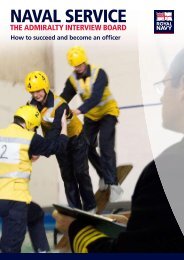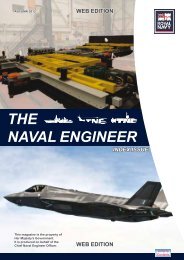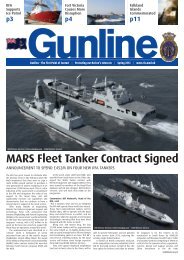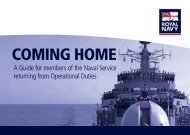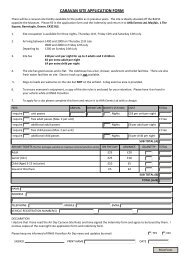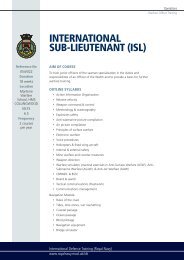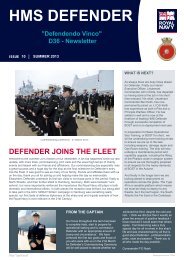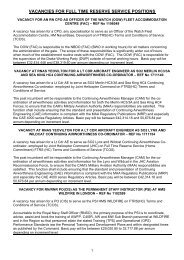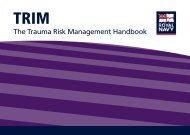THE NAVAL ENGINEER
THE NAVAL ENGINEER
THE NAVAL ENGINEER
Create successful ePaper yourself
Turn your PDF publications into a flip-book with our unique Google optimized e-Paper software.
45<br />
of aircraft that were entering<br />
service with the RN; from 1939 all<br />
aircrew entering Naval service were<br />
RNVR(A). By the end of the war,<br />
numbers had increased to 46,000;<br />
this included aircrew and support<br />
personnel including engineers. The<br />
Branch was rapidly run down after<br />
the Second World War and ceased<br />
to exist by the end of 1945. Created<br />
again in 1946, the Branch recruited<br />
former wartime aircrew, and at its<br />
peak operated 12 squadrons of<br />
aircraft – but was disbanded along<br />
with RAFVR Squadrons in the 1956<br />
defence cuts.<br />
In 1980 the RNR Air Branch formed<br />
as an all-Officer structure with 33<br />
aircrew officers who had recently<br />
left the RN. Liable for recall to<br />
service, they attended an annual<br />
two-week ‘training camp’ at an Air<br />
Station to refresh their perishable<br />
aircrew skills and then returned to<br />
their civilian jobs for the rest of the<br />
year. The idea was that if recalled to<br />
service during the Cold War period,<br />
their ‘flash-to-bang’ time would be<br />
relatively short. The Branch grew<br />
slowly and it took 10 years before<br />
the size increased to 80. In 1994,<br />
under Flag Officer Naval Aviation<br />
(FONA), the Branch opened its<br />
doors to all FAA ranks, rates and<br />
specializations: it was at this point<br />
that the first AE Ratings became<br />
part of the Branch. The Branch<br />
continued to grow, peaking at 431<br />
in 2003.<br />
The reservist used to be identifiable<br />
by the ‘R’ in the executive curl of<br />
officer’s rank lace and the ‘Royal<br />
Naval Reserve’ shoulder-flash worn<br />
by ratings on Number 1 uniform.<br />
These were both removed in<br />
2005 and are now only worn by<br />
honorary RNR officers and URNU<br />
undergraduates who are nondeployable.<br />
<strong>THE</strong> RNR AIR BRANCH TODAY<br />
The current Requirement for<br />
the RNR Air Branch is 320, with<br />
every specialisation of the FAA<br />
represented. With approximately<br />
100 aircrew, 100 AE/SE personnel<br />
and 100 operational support<br />
personnel. The officer/rating split<br />
is about 50/50 across the Branch<br />
although in the AE/SE area this is a<br />
5/95 split in favour of ratings.<br />
Unlike the mainstream RNR units<br />
which parade as formed units on a<br />
weekly basis and carry out training<br />
programmes in preparation for<br />
periods of mobilisation, Air Branch<br />
personnel are each assigned to<br />
a FAA unit. The majority of these<br />
units are at RNAS Yeovilton,<br />
RNAS Culdrose and the<br />
Commando Helicopter Force<br />
which is part of Joint Helicopter<br />
Command, such as:<br />
• Squadrons.<br />
• Force Headquarters.<br />
• Air Engineering Departments.<br />
• Air Departments.<br />
• Meteorology Departments.<br />
• Survival Equipment Sections.<br />
• Engineering Training Schools.<br />
• Second-line workshops.<br />
• Simulators.<br />
• Air Traffic Control.<br />
• RN School of Fighter Control.<br />
• Fire Stations.<br />
• Photographic Sections.<br />
The remainder of the Branch is<br />
spread thinly across the UK in<br />
places such as:<br />
• NCHQ.<br />
• RNAESS at HMS Sultan.<br />
• 1710 Squadron in Portsmouth<br />
Naval Base.<br />
• Project Teams within DE&S.<br />
• Air Experience Flights.<br />
• FOST.<br />
• Maritime Battle Staff.<br />
• Defence Survival Training<br />
Organisation.<br />
PAY, BOUNTY & COMMITMENT<br />
Air Branch personnel have an<br />
Annual Training Commitment (ATC)<br />
of 17 days per year and are subject<br />
to call-out for mobilized service.<br />
Serving with Squadrons<br />
Reservists are paid a daily rate<br />
of pay commensurate with their<br />
RNR rank/rate, this is lower than<br />
regular rates of pay as the x-factor<br />
is not paid to reservists. Specialist<br />
pay is paid where appropriate. A<br />
Reservist completing ATC is entitled<br />
to a tax-free bounty payment<br />
at the end of the training year.<br />
Additional achievement over the<br />
17 day commitment does not attract<br />
additional bounty.<br />
APPLICATION AND JOINING<br />
All Air Branch reserves are exregular,<br />
primarily RN or RM<br />
personnel recruited within three<br />
years of leaving full time service<br />
to form a pool of “Experience in<br />
Reserve”. All join in their substantive<br />
rank up to Lieutenant Commander<br />
or CPO, occasionally WO; they are<br />
selected for their particular specialist<br />
Service skills, experience and<br />
personal qualities. The philosophy is<br />
the retention of existing skills rather<br />
than teaching new ones, though<br />
opportunities for retraining can occur<br />
to suit operational requirements.<br />
Applications to join the Branch<br />
are accepted from between<br />
12 months before Tx date and up<br />
to three years after leaving full-time<br />
service. Selection and retention<br />
is competitive – Aircraft Force<br />
Commanders, Air Station Cdr (Air),<br />
Cdr (AE) and Squadron CO are<br />
consulted before an application is<br />
accepted or rejected.<br />
Recent patterns of retention of<br />
regulars to age 45 and 50 have<br />
encouraged significant over-age<br />
recruiting and the average age<br />
of the Branch is about 48. Most<br />
applicants are senior ratings or<br />
officers who have completed a<br />
significant number of years’ service<br />
and wish to retain contact with the<br />
RN. Historically less than 5% of<br />
applications are from junior ratings.<br />
Applicants who apply before in<br />
advance of their Tx date can be<br />
seamlessly transferred from the RN<br />
to the RNR subject to a medical<br />
which is usually carried out at the<br />
same time as their RN leaving<br />
medical; personnel who have left the<br />
RN before applying have to apply<br />
Jump to<br />
Contents



